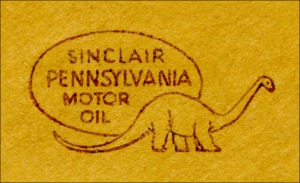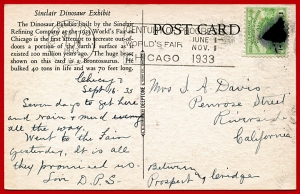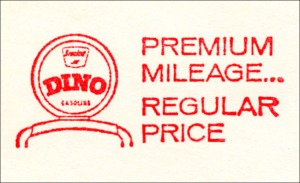After collecting Sinclair dinosaur postage metered mail for so long since first preparing an exhibit (30 years is a long time!), it’s time to revise the old exhibit. So, starting with the two initial logo designs, here’s the first 12 pages. Click on the title page to view the exhibit pages.
Category Archives: Dinosaurs
Sinclair Dinosaur Postage Meters – Part 2
Dates of use for the Sinclair postage meters (Part 1) are not recorded anywhere that I’m able to find, so I’ve started and maintain this listing along with several other collectors (Mr. Saul Friess of Miami, Mon. Dominique Robillard and Mon. Maurice Gardiol of France). We hope this is of use to you in your search for ‘Dino’ the dinosaur!
Design 1
Type 1-O (Meter #, Color, EKU, LKU)
- 00000 Blue 11-01-34 Specimen
- 01008 Green 06-04-40 08-01-40
- 01027 Blue 11-14-36 03-10-39
- 01027 Green 03-14-39 03-31-39
- 01111 Red 11-06-34 —
- 01111 Green 05-01-36 11-05-37
- 01144 Blue 09-21-38 12-09-38
- 01153 Blue 11-10-34 12-04-34
- 01248 Red 10-26-34 12-04-34
- 01712 Green 10-17-39 06-13-41
- 55098 Blue 05-27-35 10-18-35
Type 1-P (Meter #, Color, EKU, LKU)
- 01027 Blue 10-10-34 12-27-34
- 01111 Green 12-08-39 01-10-39
- 01144 Green 03-22-35 06-02-37
- 01144 Blue 02-02-38 05-04-38
- 01248 Red 04-05-35 01-17-36
- 01712 Green 11-04-41 03-02-42
- 55098 Blue 06-08-35 06-29-35
Design 2
Type 2-O (Meter #, Color, EKU, LKU)
- 00000 Blue 07-19-34 Specimen
- 12101 Blue 03-07-36 —
- 12526 Blue 10-22-35 —
- 80042 (red) 10-05-37 (reported)
- 80893 Blue 04-25-39 07-20-39
- 81740 Blue 05-02-36 —
- 81874 Blue 08-23-35 —
- 82001 Blue 06-04-36 —
Type 2-P (Meter #, Color, EKU, LKU)
- 12526 (blue) 10-06-34 (reported)
- 80893 Blue 05-05-38 —
- 81740 Blue 09-17-35 (04-22-37)
CAM74 Flight Cachet
Vernal is a small city in the Ashley Valley of the Unitah Mountain range which lies in the northeastern corner of Utah. The area was inhabited in prehistoric times by dinosaur giants and today is the site of tourism as it is near Dinosaur National Monument on the Colorado border.
Contract airmail was instituted through the Airmail Act of 1925 (Kelly Act) which authorized the U.S. Postmaster General to contract with private airlines to carry the U.S. mail. Routes were given Contract AirMail (CAM) numbers and awarded to various airlines.
Served by the Vernal-Unitah County Airport, Challenger Airlines was awarded Contract Airmail route number 74 on May 10, 1947 with service to various cities in Colorado, Utah and Wyoming. Service to Vernal was initiated on 1 July, 1949 with two routes – one to Salt Lake City to the west and a second to Evanston to the northwest. The flights connecting from those cities took the mail in all directions.
Special First Flight Cachets were instituted to mark the initial flights and in the case of Vernal, a local hand-stamp was used commemorating the airport dedication as well. This hand-stamp is found on the rear of envelopes and is present on covers carried on both routes.
The northwest route morning flight was postmarked at 7AM and piloted by R.D. Nicholson. Addressed to Philadelphia, PA, this cover used the northwest route through Evanston and was backstamped along the route at Rock Springs, Wyoming at 10:30AM.
The westward route afternoon flight was postmarked at 12PM piloted by Harry Mitchell. Addressed to San Francisco, CA, this cover used the western route through Salt Lake City and was backstamped along the route at Salt Lake City at 6PM.
Sinclair Oil Company Post Card for 1933 Century of Progress
The ‘Century of Progress International Exposition’ was held during 1933-1934 in celebration of Chicago’s centennial. Also known as the Chicago World’s Fair, the most advanced technology available was on display for the pleasure of attendees. One of the more popular pavilions was Sinclair Refining Company’s 2 ton, animated exhibit of ‘Dino the Dinosaur’. The intent was to associate the origin of the product’s raw materials with vast age, insinuating it was better quality. People could not fathom how large these animals really were until they stood near this giant and even then, it was difficult to believe. The dinosaur’s popularity resulted in the company’s use on mail advertising beginning the same year in the form of Sinclair Dinosaur Illustrated Postage Meter Slogans.
Text on the rear of the post card reads:
“Sinclair Dinosaur Exhibit – The Dinosaur Exhibit built by the Sinclair Refining Company at the 1933 World’s Fair in Chicago is the first attempt to recreate out-of-doors a portion of the earth’s surface as it existed 100 million years ago. The huge beast shown on the card is a Brontosaurus. He bulked 40 tons in life and was 70 feet long.”
O.C. Marsh, Chief Red Cloud and the Thunderhorses
The American west was a fertile landscape for fossil hunters of the late 1800s. Remains of fish, giant shells and bones were recognized as fossils by geologists and surveyors preparing the untamed land for the transcontinental railroad in the 1860s. They reported their findings to scientific journals and sold articles describing their experiences to newspapers in the east. These enticing discoveries also had their hazards as the American Indians living in the areas were unwelcoming hosts to these pale-faced newcomers.
A rush to uncover western fossil riches began in 1871, the same year Yellowstone and the Grand Canyon were being explored. Reports of undocumented fossil types by these new expeditions lured major scientists into the great outdoors regardless of the hardships. One of the most renown of these new explorers was Othniel Charles Marsh, a professor of paleontology at Yale College in New Haven, Connecticut.
Marsh explored many western sites with mixed results after receiving various geologic reports and maps. On hearing of interesting samples found in the Dakota badlands, he decided to explore the area in November of 1874. This move into the Wyoming Territory was accompanied by a full entourage of wagons and a number of hired hands to do the lifting and digging.
The starting point for this expedition was an Indian agency not far from a railhead belonging to the Northern Pacific Railroad. The agency was named for Chief Red Cloud, the local Oglala Sioux war leader and chief. Chief Red Cloud lead the resistance during the Indian wars at Powder River hunting grounds where the U.S. Army was soundly defeated. After this conflict, he settled near the agency after the army agreed to close forts in the area and spent his remaining years mediating differences between the white man and the Sioux.
Evidence of gold quartz had also been found in earlier expeditions and that news brought many unwelcome fortune hunters onto Sioux lands. Marsh arrived white skinned and a stranger to the area. To the Sioux, these two traits marked him as another gold seeker. Some were so upset by his presence, especially by the number of wagons and men he brought with him, that they demanded the local Indian agent tell him and his party to return to the train and leave the area.
Marsh, a stubborn man by nature, refused to leave and insisted on meeting Red Cloud to discuss the purpose of his expedition. On hearing of this white man’s refusal to leave, even after being told to do so by the Indian agent, Red Cloud’s curiosity outweighed his distaste and he agreed to talk. The meeting resulted in Marsh obtaining Red Cloud’s permission to look for fossils on Sioux lands. The Sioux were also familiar with fossils and called the remains ‘Thunder Horses’ in recognition of their size.
Using his maps and following Red Cloud’s instructions, Marsh found several wagon loads of fossils and returned to the agency so the Indians could examine the rocks and fossils. After seeing that no gold was secretly hidden and Marsh had kept his promise, Red Cloud was impressed with his honesty and invited him to visit the nearby Sioux encampment.
While in the Sioux encampment, Marsh viewed food and supplies provided by the U.S. government’s Bureau (Office) of Indian Affairs and became outraged after seeing spoiled foodstuffs and poor quality goods in terrible condition. He heard accounts of general corruption among U.S. government officers and agents. Returning east, Marsh reported on ‘our vile bureaucrats’ to anyone who would listen, but few did.
The matter did not end there as Red Cloud sent further information to Marsh in the Spring of 1875 indicating no supplies had been provided to the Sioux after Marsh left the agency. Public reaction was immediate when Marsh reported these further activities to the New York Herald newspaper resulting in a series of articles outlining the misdeeds of the Interior Department’s Bureau of Indian Affairs.
Shortly thereafter, President Ulysses S. Grant “regretfully accepted” the resignation of Christopher Delano, U.S. Secretary of the Interior. A full investigation of the Bureau of Indian Affairs followed and Red Cloud’s Oglala Sioux finally received the subsistence aid they were promised.
Red Cloud was impressed with Marsh’s continued efforts and named him “the best white man I’ve ever seen”. Further explorations by Marsh’s workers were always accompanied by Sioux braves to protect and guide the diggers. In 1880, Red Cloud visited Marsh in New Haven and the two men became fast friends.
The cover illustrated below was posted from the Red Cloud Agency No.2, Nebraska on June 25, 1875 (year date in manuscript) and is addressed to Professor O.C. Marsh at Yale College in New Haven, Connecticut.
The script docketing on the side indicates the letter was posted by H.E. Farnam using an imprinted envelope of J.W. Dear, an Indian trader at the agency. This likely indicates the content was not trader or agency business, but rather an envelope used on behalf of a third party.
As the contents are no longer with the cover, the following is speculation based on historical information. Very little mail was sent from the Red Cloud Agency addressed to Marsh. This cover correlates with the reported springtime message sent by Red Cloud to Marsh and may well have been the one asking for assistance with his continuing problems with the Bureau of Indian Affairs. It’s a gem of a cover and historical testimony to Marsh’s presence and activity in Wyoming. 
* Office of Indian Affairs penalty cover courtesy of Lester C. Lanphear III
Sinclair Dinosaur Postage Meters – Part 1
Mail of the Sinclair Oil Company from 1934 through 1968 utilized postage meters with illustrated advertising slugs which included the likeness of a dinosaur. The image of ‘Dino the Sinclair Dinosaur’ as the company logo was used to indicate the age of the raw materials used to make their oil and gas products.
Examples of this mail are the earliest items to depict dinosaurs and represent the scarcer philatelic material available in this thematic subject. Over the span of 40 years collecting these meters, nine basic designs of the advertising slug have been recorded from the U.S. and three types internationally. The major varieties on six of the U.S. basic designs are shown below.
In future posts, we’ll discuss the cities of origin, meter machine numbers, machine manufacturers, corner cards, and sub-varieties such as ink color, are also of interest. For the moment, let’s review only the basic designs. The dates of use listed are those years I’ve been able to verify and they may change as more information is obtained. Your assistance is always welcomed and solicited to further clarify the use of these advertising postage meters.
Please note – the words ‘Opaline’ and ‘Pennsylvania’ refer to oil types. Opaline was a brand purchased by Sinclair and retained its name under Sinclair ownership.
Design 1
Comes in two types. The text bubble is directly above the dinosaur and the dinosaur measures 33mm wide by 16mm high. The readily apparent difference is in the text – ‘Opaline’ in the first type as opposed to ‘Pennsylvania’ in the second. The ‘Opaline’ type also includes a small line of text ‘REG. U.S. PAT. OFF.’ (Registered United States Patent Office) below the word ‘Opaline’. Used from 1934 through 1942.
Design 2
Comes in two types. The text bubble is above the dinosaur’s tail and the dinosaur measures 32mm wide by 12mm high. This design looks similar to design 1, but the smaller size of the dinosaur is readily visible. Used from 1934 through 1939.
(NOTE: Even though this design uses an earlier machine type, the earliest date known is after the use of type 1)
Design 3
Comes in two types. The text bubble is above the dinosaur and extends to the left. The dinosaur measures 25mm wide and 11mm high. This dinosaur is much more elongated body than in the first two designs. Used from 1940 through 1959.
Design 4
Comes in two types. The text bubble is above the dinosaur and the dinosaur measures 31mm wide and 13mm high. This dinosaur is similar to design 3 but larger overall. Used from 1940 through 1950.
Design 5
Comes in only one type. The text is not in a bubble and the dinosaur now wears a jacket, bow tie and hat reminiscent of those worn by gas station attendants of the time. Used from 1957 through 1963.
Design 6
Comes in two types. The size of the advertising slug differs, 6a being 44mm wide and 19mm high and 6b being 50mm wide and 25mm high, both with a tiny dinosaur image in the Sinclair logo. Used from 1962 through 1964.
Design 7
Comes in only one type. This design utilizes an oil can as the main theme with the image of ‘Dino’ being a small detail (similar to a design used in Belgium). Used during 1963.
Design 8
Comes in only one type. This design was an advertisement for the Sinclair Oil Company’s ‘Dinoland‘ pavilion at the New York World’s Fair. Used from 1964 through 1965.
Design 9
Comes in two types. The name ‘Dino’ is in text and no illustration of the dinosaur is part of the design. The variation occurs in the wording: ‘Play Double Dino Dollars’ or ‘Play New Dino Dollars’. Used during 1968.
British Prehistoric Animals – First Day of Issue
The new set of prehistoric animal stamps from Great Britain was issued today. They include:
Polacanthus
The heavily armoured Polacanthus was protected from predators by a host of spikes and studs.
Ichthyosaurus
Adapted to life in the sea, the Ichthyosaurus breathed air and gave birth to live young in the water.
Iguanodon
The herbivorous Iguanodon was able to walk on all fours, but would run using only its hind legs.
Ornithocheirus
This relative lightweight flew mainly by soaring and gliding, catching fish by skimming the sea.
Baryonyx
With a name meaning ‘heavy claw’, the thumb claw alone of the Baryonyx was more than 40cm long.
Dimorphodon
With its one metre wingspan and two types of teeth, the Dimorphodon preyed upon fish.
Hypsilophodon
The long shins of the Hypsilophodon suggest that a speedy escape was its main means of defence.
Cetiosaurus
The Cetiosaurus was a herbivore thought to weigh as much as 20,000kg, the same as 20 cars.
Megalosaurus
The fearsome Megalosaurus grew up to nine metres in length, and preyed upon other Dinosaurs.
Plesiosaurus
With its vast paddles, the Plesiosaurus hunted fish and other marine prey at an estimated 8kph.
Sinclair Postage Meter from Belgium
Regardless of how long we collect, there is always something that eludes us, sometimes for many years as is the case with this item. We know of these things often by accident and it’s only as a matter of luck that I even have this image.
‘Dino the Sinclair Dinosaur’ was a popular motif used as a logo by the Sinclair Oil Company. First used during the early 1930s and then again during the 1950s and 1960s, several major design styles were used as advertising on metered mail from a number of larger cities in the U.S. In addition, at least three countries other than the U.S., namely Belgium, Italy, and Venezuela also used versions of the logo on metered mail.
So, my search continues and that’s part of the lure of collecting, the chase is often more fun than the possession… That said, I’d still like to own a copy of this meter some day.
T. rex Missing Color Error
One of the favorite item types in my prehistoric collection is errors of stamps, be they misperforations, colors missing or other odd ducks. In this U.S. color error, the black normally indicating a value and the text for the country of issue is missing. It’s one of those things you love for no other reason than it’s cool – even though other things may be more rare or important.
This U.S. issue designed by James Gurney is one of the most dynamic images of the Tyrannosaurus yet to appear on postage stamps.




























